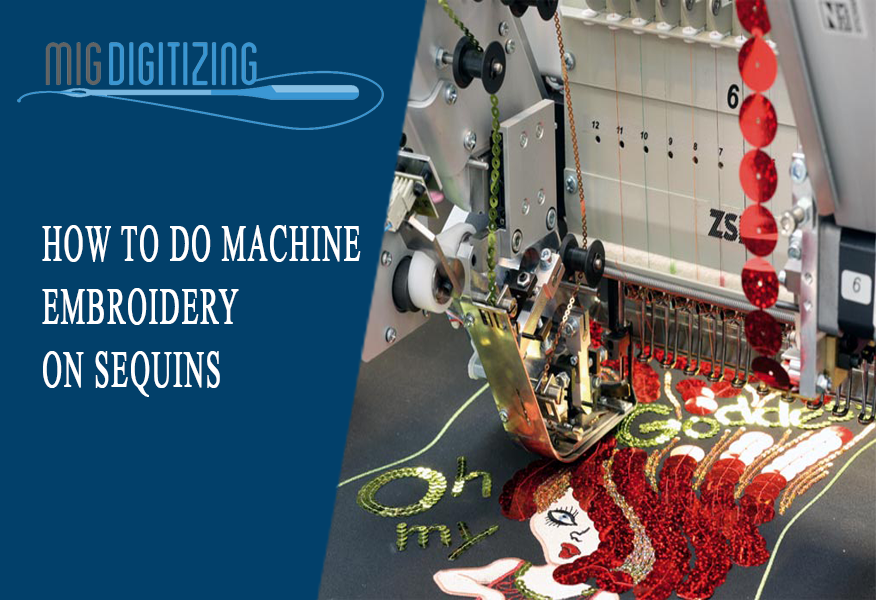
Creating a high-quality machine embroidery design on sequined fabric can be intimidating but is surely a rewarding experience. Your fabric design will not only surpass other unique designs but will also enhance your skills in terms of creating outstanding designs with the machine.
You don’t have to worry about anything related to sequin designs with machine embroidery. The only thing you need to do is to put a little extra effort and care into the design.
In this blog, we will discuss with you how to do machine embroidery on sequin fabric. Read this few-minutes blog and you will be good to go.
Machine Embroidery on Sequins
Embroidering on sequin fabric is truly worth having experience. It is easy to get excellent results with little attention to details. You need to go ahead step by step when you are creating sequin design. It is crucial to consider the number of steps and execution factors.
After all, embroidering on sequin with the machine is a bit challenging as the fabric involves plastic disks (in addition to fabric), a richly textured mobile surface and a high shine in many cases. However, if you do it properly, you can achieve the best outcome without any hassle.
Let’s dive into the process without any further ado
Picking up the Designs for Machine Embroidery Sequins
The first that you may need to consider is the right selection of compatible embroidery design for sequin project. If you choose the wrong design, you might face difficulties in the long run. It is because of the uneven, unstable, and raised structure of the sequin that affects the stitches that cover it.
The sequins will probably shift during the embroidery stitch process that in turn ruins the effect of precise details. However, the fill stitches will still show the sequins outlines that lay underneath the embroidery design. The design for the sequined tank has two main features. The stylized rose blossom and leaves. Blossom is created using long satin stitches and leaves of fill stitches.
If the design consists of satin stitches, the stitches should be long enough so they can float over the sequin easily. The long satin stitches can have tension stitches and are prone to snagging. Their length should be moderate enough to create eye-catching effects. The designs having fill stitches will probably reveal sequin texture laying under the stitches.
The exposed texture amount is determined by the relative density of fill stitches. The lightweight radial in the design shows the white texture while still giving the required amount of the coverage. This creates an appealing contrast between the sequined texture of leaves and smooth stitches of blossoms. Regardless of which type you go with, it is better to pick up the designs that are simple and bold. Small lines and details may obscure by the sequin texture.
Understanding the Color Theory for Sequin Embroidery
There is a competition between the shine generated by sequins so there should be enough colour contrast to impact the fabric. From some tests of several colour combination, it is clear that many of the thread colour combinations did not stand out for the sequin and faded. A good tip here is to test colours this way. It will allow you to choose the ideal and necessary technique for stitching on sequin before you go for the final design.
Stabilize the Sequined Fabric
The sequin fabric is made up of a knit having sequins attached to it. The structure of the mesh gives the opportunity to sequin to drape due to its lightweight. It then reduces the overall weight. It is crucial to support the mesh as it is quite delicate for doing embroidery.
It is recommended to use a cutaway stabilizer to assist the sequin fabric when stitching. To maintain the natural fabric drape, you need to use the two layers of lightweight cut-away stabilizer instead of a single heavy cut-away stabilizer layer. This helps and makes it easier to trim the stabilizer after embroidery.
A bonus tip here is to use pinking shears for grading stabilizers. This will create clear and invisible edges.
Doing Stitching on Sequin Embroidered Designs
Sequin embroidery means stitching on plastic. Therefore, it is recommended to use a sharp needle. A topstitching needle works the best. You can use a needle having a size (90/14 or 100/16). Using such sizes can protect the thread when the needle passes through a solid plastic.
It is vital to adjust the embroidery foot height. This will keep sequins secure when stitching. If the sequins are shifting, lower the foot to reduce space between stitches and the foot. There are many specialities of threads and fabrics. The speed is another consideration. One thing to keep in mind is that moderate and slow speed helps to reduce the thread breakage caused by friction and needle heat. If you encounter any of these problems, try to decrease the stitch rate.
These are the tips and tricks on how to do embroidery on a sequin. The process is not difficult. All you need is to stick to these steps and you are good to go. If you still have any queries, you can contact our customer care team. They will endeavour to answer your questions.



